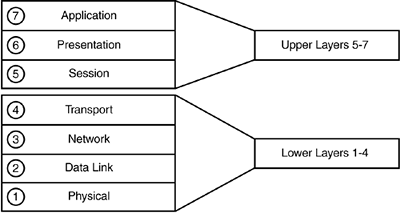OSI Model
The application of a layered framework to networking allows individual layers to be modified, without affecting the layers above or below. The OSI model can be thought of as the networking community's application of the concept of interchangeable parts.
Figure 1-1 illustrates the seven layers of the OSI model. Each layer is tasked with specific functions that allow for the eventual communication of network devices. Note that the model is divided into upper layers and lower layers, which are described in the next sections.
Figure 1-1. OSI Layers

OSI Upper Layers
The upper OSI layers provide application level support such as the user interface, data formatting, and communication sessions. The upper layers are as follows:
Application? The layer where applications and users interface with the network. Examples include web browsers, electronic mail, or a word processing program.
Presentation? The layer that controls format translation and provides data encryption and compression. Examples include ASCII and JPEG.
Session? The layer responsible for establishing, maintaining, and terminating sessions between presentation layer entities. Protocols that fall at this layer include NetBIOS and RPC.
OSI Lower Layers
The lower OSI layers define how data moves through the network. Because Ethernet itself and the switching of Ethernet frames are classified in the lower OSI layers, most of the discussion in this book focuses on the lower layers. The lower layers of the OSI model are as follows:
Transport? The layer responsible for error detection and correction, flow control, and data sequencing; also determines the size of the packet. Examples include Transmission Control Protocol (TCP) and User Datagram Protocol (UDP).
Network? The layer responsible for the delivery of data packets. Network layer provides logical addressing and path determination. Examples include Internet Protocol (IP) and Internetwork Packet Exchange (IPX).
Data Link? The layer responsible for access to media, hardware addressing, error detection, flow control, and encapsulation of data into frames. The two major components to Data Link layer are Logical Link Control (LLC) and Media Access Control (MAC). LLC handles error detection and flow control. MAC is responsible for communicating with the adapter card, and the type of media used. Examples include IEEE 802.3 CSMA/CD, 802.12 Demand Priority, and 802.5. Bridges and LAN switches also operate at this layer.
Physical? The layer responsible for defining the electrical properties and physical transmission system. The physical layer is responsible in transmitting and receiving data. Examples include any type of cabling, hubs, repeaters, and fiber optics.







